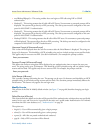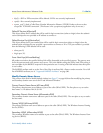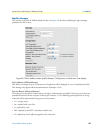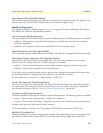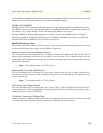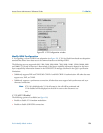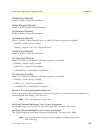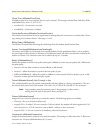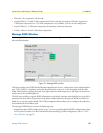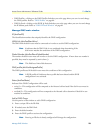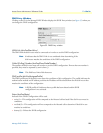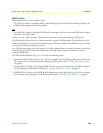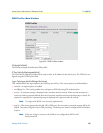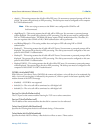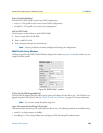
Dial In Modify default window 76
Access Server Administrators’ Reference Guide 7 • Dial In
Guard Tone (diModemGuardTone)
Normally a guard tone is not required, but one can be inserted. This setting works for Phase Shift Key (PSK)
modulations only, not for V.32 or V.34.
• tone None(1)—Guard tone is not used
• tone1800(3)—Guard tone is enabled
CarrierLossDuration (diModemCarrierLossDuration)
The number of seconds that the carrier signal must be missing before the connection is considered lost. Choos-
ing a setting of 25 indicates forever. The range is 1 to 25.
Billing Delay (diBillingDelay)
The number of seconds after answering the call during which the modem should remain silent.
Answer Tone Length(diModemAnswerToneLength)
The answer tone length can be adjusted for low speed modems. If only modulations below v.34 are enabled,
the tone length can be reduced to a minimum of 1 millisecond which will reduce the total time it takes for the
modem to connect. The connection time can be reduced by up to 3.5 seconds.
Retrain (diModemRetrain)
Enables the modem to monitor line quality and request a fallback or retrain for poor quality and a fall forward
for good quality.
• none (0)—Do not allow modem to retrain, fallback, or fall forward.
• retrain(1)—Allow the modem to retrain if the line quality is poor.
• FallForwardFallBack(2)—Allow the modem to fallback to a slower speed if the line quality is poor, or fall
forward to a faster speed if the line quality is good.
TxLevel (diModemTxLevel)—Not Currently in Use
This variable should be set with caution; and normally only after talking to a factory representative. This sets
the transmit level power level of the modem. The scale is 12 (-12 dB) to 20 (-20 dB) in 1 db increments.
Note
Larger numbers mean less transmit power is being output (in other words, a
setting of 20 will result in less power than a setting of 12).
Protocol (diModemProtocol)
Assigns the error correction protocol to use with the modem. The following options are available:
• Direct(0)—No error correction will be used.
• requestV42(1)—Enables V.42 error correction. If this is selected, the modem will either negotiate for V.42
error correction or—if V.42 correction is not available—will use no error correction.
• requireV42(2)—V.42 error correction is mandatory, otherwise disconnect.
Compression (diModemCompression)
Assigns the data compression protocol to use with the modem. This setting is in effect only when V.42bis error
correction (see
“Protocol (diModemProtocol)”) is active.



